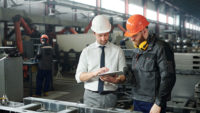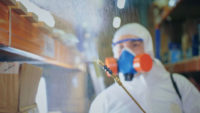According to the Environmental Protection Agency (EPA), Americans spend on average 90 percent of their time indoors. Whether this is at home, in the office, at school or otherwise, these environments often exhibit air pollutant concentrations two to five times higher than the outdoor equivalents. In industrial settings, dust can be a regular annoyance and often at its worst, a deadly hazard.
If you perform dust generating processes, which most businesses in manufacturing, extraction, food processing, engineering and construction will, the first step is to identify these processes and understand the substances involved and aim to control the level of exposure and protect those exposed. The Occupational Safety and Health Administration (OSHA) respiratory standard requires employers to develop and implement a respiratory protection program for when Permissible Exposure Limits (PELs) of airborne contaminants could be exceeded.
Even indoor areas away from these processes can be exposed to airborne contaminants, such as communal areas where cleaning products are used, mold and moisture, pests and even the appliances that people use, can all impact air quality. Employees may not be exposed to dangerous levels of airborne hazards on site but even if there is a chance that they might be, measurements can be taken to understand exposure levels and as part of a risk assessment. After the measurements have been taken you make a reasonable judgement about what control measures and other actions are needed, reducing exposure levels to as low as is practicable (ALARP)
Airborne concentrations should be kept below 3 mg/m³ (respirable particles) and 10 mg/m³ (inhalable particles) for dust with no Threshold Limit Value (TLV). The more toxic a dust is the lower the permissible exposure limit and therefore TLV.
In this instance, inhalable dust is any dust that can be breathed into the nose and mouth and respirable dust, the fine particles, penetrates beyond the terminal bronchioles into the gas-exchange region of the lungs, hence are more dangerous for employees.
Know the process
Many dusts have specific exposure limits and many dusts are a mixture of different substances, some of which are covered by the general dust exposure limit and others by their own TLV.
The dust itself might not be an issue, but there may be a toxic component to the dust so always check and use up-to-date safety data sheets. For example, a metal being grinded may have something like nickel or chromium in it, in which case you’ve got to control to a much greater degree.
Sometimes, it can be obvious that there is an unhealthy volume of dust in the workplace. Large clouds of dust constantly being generated will be visible to the naked eye and efforts should be made to minimize the prevalence. However, as the most dangerous types of dust are invisible, sampling in cases where there is a possibility that microscopic particles of dust are produced is a necessity.
People also tend to focus on the wrong processes, perhaps the saw, where there is a lot of dust deposited on the floor. But they miss processes that are most likely to produce potentially high exposure, such as sanding or routing, which produce a much finer dust that stays suspended in the air for longer periods, travels further, and is more dangerous to those exposed.
Sampling
Exposure limits are based on personal samples, so the best way to guarantee the safety of your employees is to use personal air sampling pumps and implement control measures from the results.
Most personal air sampling pumps are Intrinsically Safe (IS) rated but it is important to check the pump’s rating to ensure it is suitable for use in a specific facility. The pumps must also adhere to the latest international standard for air sampling pumps. Compliance to ISO 13137 ensures accurate flow performance amongst other performance criteria, ensuring accurate sampling and meaning you won’t have to repeat measurements.
When selecting the pump you intend to use for sampling, design characteristics like robustness and comfortability for the wearer must also be considered. The pumps should also allow freedom of movement and be unobtrusive so that workers can conduct their duties unimpeded.
Before use, pumps must be calibrated using a representative sample. They should also be checked at the end of the day to make sure flow has not deviated by more than 5%, if it has, there may be a leak or another malfunction.
Sampling procedures should be designed to ensure accurate and consistent collection of dust concentration samples that correctly reflect the dust levels at the specified sampling locations and times.
Control hierarchy
In controlling dusts, the usual risk control hierarchy applies:
- Eliminate dust generating processes where possible
- Change the process to emit less dust
- Enclose the process so that the dust does not escape or extract dust near the source using local exhaust ventilation (LEV)
- Ensure as few workers are in harm’s way as possible
- Provide respiratory protective equipment (RPE) such as a respirator
The hierarchy is put in place to effectively control the risk to workers. If you can alter the process or use materials without a toxic component, or in a form that doesn’t generate exposure, it’s better than having to control the dust.
When it comes to the selection and installation of Local Exhaust Ventilation (LEV) systems, it's crucial to understand several key factors: the particle size, the release rate, the quantity, and the nature of the surrounding atmosphere where it will be employed. It is advisable to thoroughly assess these factors before installing a system, and it is prudent to engage the services of a specialized LEV installer.
Relying too heavily on LEV systems is a common mistake. People often assume that an LEV system will successfully capture all airborne particles but if the system is poorly designed/maintained or inappropriate for the specific dust involved, the LEV will not be effective.
Knowing the risks that workers are exposed to and appropriately controlling them is one of the most essential roles of an employer. Find out the hazards present, sample the quality of the air and implement effective control measures to preserve employees health and avoid the penalties for noncompliance.



